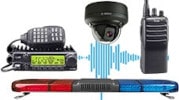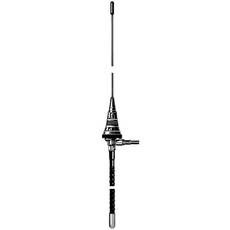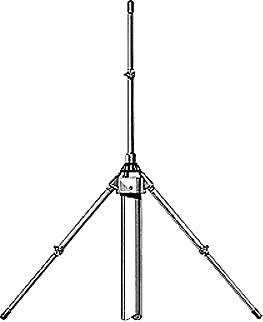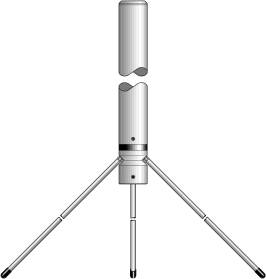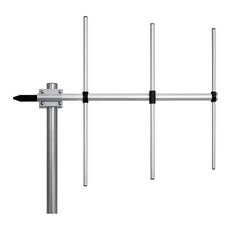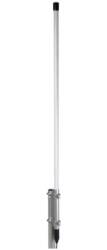Airband Antennas
- further categoriesAirband antennas can be used to communicate with air traffic control during take-off and landing, but they can also be used to signal distress or give your position. This type of aircraft antenna is particularly suitable for use in air sports equipment, gliders and balloons. This type of antenna can also be mounted on plastic and other non-metallic surfaces. This is possible with dipole technology. Read more...
• Type: Dipole 1/2 λ with loaded radial
• Frequency range: 118-137 MHz for areonautical band
• Impedance: 50Ω
• Radiation (H-plane): 360° omnidirectional
• Polarization: linear vertical
• Gain: 0 dBd - 2.15 dBi
• Max. Power (CW) @ 30°C: 50 Watts
• Cable Length / Type: 5 m / RG 58 with FME-female
• Type: 1/4λ ground plane
• Frequency range: tunable 108-136 MHz
• Impedance: 50Ω
• Radiation (H-plane): 360° omnidirectional
• Radiation (E-plane): beamwidth @ -3 dB = 86°
• Radiation angle: 0°
• Polarization: linear vertical
• Gain: 0 dBd, 2.15 dBi
• Bandwidth @ SWR ≤2: ≥12.2 MHz @ 108 MHz
• SWR @ res. freq.: ≤ 1.2 @ start freq.
• Max. Power (CW) @ 30°C: 500 Watts
• Connector: UHF-female
• Type: 1/4λ ground plane large band
• Frequency range: VHF AIR band, RX 108-136MHz, TX 118-136MHz @SWR ≤2
• Impedance: 50Ω
• Radiation (H-plane): 360° omnidirectional
• Radiation (E-plane): beamwidth @ -3 dB = 78°
• Radiation angle: 0°
• Polarization: linear vertical
• Gain: 0 dBd, 2.15 dBi
• Max. Power (CW) @ 30°C: 1000 Watts
• Grounding protection: All metal parts are DC-grounded, the inner conductor shows a DC short
• Connector: N-female
• Type: 3 elements yagi antenna
• Frequency range: 108-118MHz @ SWR ≤1.5, 118-137MHz @ SWR ≤2.0
• Impedance: 50Ω
• Radiation (H-plane): beamwidth @ -3 dB = 150° @ center freq.
• Radiation (E-plane): beamwidth @ -3 dB = 70° @ center freq.
• Front to back ratio: ≥ 12 dB
• Polarization: linear vertical or horizontal
• Gain: 4.85 dBd, 7 dBi
• Max. Power (CW) @ 30°C: 200 Watts
• Grounding protection: All metal parts are DC-grounded, the inner conductor shows a DC short
• Connector: N-female with rubber protection cap
Special gross price: 124.69€ (Net price: 98.18€)
• Type: 1/2λ ground plane
• Frequency range: TX 118-136, RX 108-136 MHz
• Impedance: 50Ω
• Radiation (H-plane): 360° omnidirectional
• Polarization: linear vertical
• Gain: 0 dBd, 2.15 dBi
• Max. Power (CW) @ 30°C: 100 Watts
• Connector: N-female
What is the frequency range in which a airband antennas operates?
Aeronautical applications require antennas designed for frequencies between 108 and 136 MHz. 108 and 118 MHz are used for aeronautical radio navigation and 118 and 136 MHz are used for aeronautical mobile communications. For this purpose, dipole or ground plane antennas are suitable.
How high should the airband antennas be mounted on the ground?
To achieve the best range, this type of antenna should be mounted as high as possible. What exactly does this mean? A minimum height of 5-10 meters above the ground is recommended. But if you can place the base antenna higher than that, you can increase its range even further.
What types of airband antennas is this antenna designed for and what applications is it recommended for?
Civilian, which includes private and business aviation, as mentioned above mostly uses the 108 to 136 MHz frequency band. Within this is the so-called navigation band from 108 to 117.975 and the communications band from 118 to 136, thus separating the two functions. That is, the first third of the total aviation frequency band is used for navigation and the rest is used for flight control.
The navigation frequency band is dominated by VOR and ILS signals. What do these abbreviations mean? VOR, which stands for Very High Frequency Omni Range, is a standard radio navigation signal that has been around since the 1950s. It helps establish the routes that aircraft use. And ILS stands for Instrument Landing System, which is similar to the previous signal but operates vertically.
It means that it is this vertical signal that planes descend to the runway following. The communication range is defined by each country. But it is divided up with neighbouring countries so that it does not cause any disruption to the two countries' air traffic control systems. This works by each country using different frequencies in areas close to each other.
What materials are the airband antennas made of?
The aircraft-mounted VHF antenna is made of chrome-plated brass, stainless steel, and a UV-resistant plastic coating. On the other hand, the baseband antennas are made of anodised aluminium, chrome-plated brass and thermoplastic UV-resistant plastic.
What range can you expect with this airband antennas when communicating over the airwaves?
Before answering this question, it is worth clarifying what the abbreviation VHF stands for. It stands for Very High Frequency, which means ultra short wave. With this type of antenna you can usually communicate with whoever you can see. A VHF antenna connected to a handheld VHF radio has a range of 5 to 6 km, but with an antenna placed 15 metres above the ground you can communicate effectively up to 10 to 12 km.
What type of connectors does the airband antennas have and what devices can it be easily connected to?
The connector of a repeater antenna depends largely on the type of antenna. For example, the Sirio MD antenna requires a FME nut connector, the GPA antenna requires a UHF socket (SO-239) and the GP Receptive Base antenna also requires a UHF socket SO-239 plus an additional N connector. The flight band antennas mounted on sports and ultralight aircraft, gliders and balloons can be connected to a flight radio, emergency beacon or combined with a transponder.
And ground base station antennas can be connected to radio stations and control centres. For this type of antenna, it is advisable to connect a state-of-the-art battery. Thanks to innovative technology, this type of antenna does not need external charging during flight.
In the DND Telecom webshop you can also buy Sirio airband antennas, which are quick and easy to install. Because these antennas do not need to be tuned.

